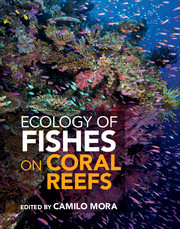Book contents
- Frontmatter
- Contents
- Preface
- Foreword
- List of contributors
- PART I BASIC ECOLOGY
- PART II PATTERNS AND PROCESSES
- PART III HUMAN FINGERPRINTS
- PART IV CONSERVATION
- PART V DEBATES AND PARADIGM SHIFTS
- 23 Is dispersal of larval reef fishes passive?
- 24 Density dependence and independence and the population dynamics of coral reef fishes
- 25 Equilibrial versus non-equilibrial dynamics in coral reef fishes
- 26 Cryptic density dependence: integrating supply-side ecology with population regulation
- 27 Priority effects
- 28 Inverted trophic pyramids
- 29 Shifting baselines in coral reef fishes
- 30 Pluralism explains diversity in the Coral Triangle
- 31 Reef fish biogeographical regions
- 32 Size and sex change
- 33 Quantifying reef fishes: bias in observational approaches
- 34 Seascape ecology of fishes on coral reefs
- 35 The future for coral reef fishes
- 36 Perpetual struggle for conservation in a crowded world and the needed paradigm shift for easing ultimate burdens
- References
- Index
28 - Inverted trophic pyramids
from PART V - DEBATES AND PARADIGM SHIFTS
Published online by Cambridge University Press: 05 May 2015
- Frontmatter
- Contents
- Preface
- Foreword
- List of contributors
- PART I BASIC ECOLOGY
- PART II PATTERNS AND PROCESSES
- PART III HUMAN FINGERPRINTS
- PART IV CONSERVATION
- PART V DEBATES AND PARADIGM SHIFTS
- 23 Is dispersal of larval reef fishes passive?
- 24 Density dependence and independence and the population dynamics of coral reef fishes
- 25 Equilibrial versus non-equilibrial dynamics in coral reef fishes
- 26 Cryptic density dependence: integrating supply-side ecology with population regulation
- 27 Priority effects
- 28 Inverted trophic pyramids
- 29 Shifting baselines in coral reef fishes
- 30 Pluralism explains diversity in the Coral Triangle
- 31 Reef fish biogeographical regions
- 32 Size and sex change
- 33 Quantifying reef fishes: bias in observational approaches
- 34 Seascape ecology of fishes on coral reefs
- 35 The future for coral reef fishes
- 36 Perpetual struggle for conservation in a crowded world and the needed paradigm shift for easing ultimate burdens
- References
- Index
Summary
Trophic representations of coral reef fish assemblages are used frequently to depict the structure and functioning of reef communities. While the trophic structure of many coral reef fish assemblages reveals prey species outweighing their predators, recent observations from little-exploited reefs suggest the opposite – inverted biomass pyramids with the mass of piscivorous predators exceeding that of their prey. Such observations are paralleled by historical accounts of predator-dominated coral reefs and suggest that when fishing is light or absent, large-bodied, long-lived piscivores can quantitatively overwhelm their prey. Inverted biomass pyramids are a well-known phenomenon within the ecological literature; however, biomass-based depictions of little-exploited coral reef fish assemblages appear to provide the first empirical evidence of inverted trophic structure among vertebrates. Inverted biomass pyramids can only be maintained if the patterns of productivity (i.e. energy flux) are bottom-heavy, suggesting that predators on coral reefs are quite slow-growing per capita, or per unit biomass, relative to their fast-growing prey. Detailed investigations are needed to distinguish among competing hypotheses for how inverted biomass pyramids might arise, with the findings likely to be of great value to the improved management of reef communities.
TROPHIC PATTERNS AMONG CORAL REEF FISHES
Historical accounts suggest that tropical nearshore ecosystems were classically home to abundant populations of large organisms, with a prominent representation of predatory fishes [1225,1226,2259]. Reconstructions of Caribbean coral reef ecosystems from early explorers suggest that sharks and other large predators were common and numerous for the first centuries following European contact [1225,2610]. However, the growth of coastal human populations coupled with active nearshore fisheries led to reductions in fish populations from coral reefs globally, including dramatic reductions in the populations of predatory reef fishes [1226,1910].
Only in the past few decades, largely since the incorporation of SCUBA diving into the study of reef fishes, have we been able to gain a clearer picture of the structure of reef fish assemblages and the ecological role played by predatory fishes.
- Type
- Chapter
- Information
- Ecology of Fishes on Coral Reefs , pp. 247 - 251Publisher: Cambridge University PressPrint publication year: 2015
- 9
- Cited by



